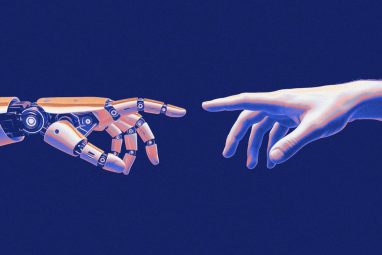The Automation Paradox in Hiring. Will Faster Decisions Mean Fewer Human Insights?
Even as employers use AI to screen talent, many resist candidates using it, highlighting a quiet tension at the heart of automated hiring.
News
- Karnataka Pushes Global Partnerships at Bengaluru Tech Summit 2025
- Anthropic Lands $15 Billion From Microsoft, Nvidia in Expansive Cloud Tie-Up
- Pichai Sets the Tone as Google Pushes Gemini 3 Across Its Entire Ecosystem
- Infosys Charts a New Path for GCCs Built Around AI
- Bezos Returns to an Executive Seat With Stealth AI Venture
- Bengaluru Tech Summit Opens With Focus on AI, Deep Tech and Startups

[Image source: Chetan Jha/MITSMR India]
What does the job market in 2025 look like? A negotiation table where an AI drafts the cover letter, while another algorithm decides whether it merits human attention. Both systems shape the exchange, yet neither truly understands what the other is optimising for — and workers are caught in the midst of this increasingly automated conversation.
“AI is here to stay, and job seekers will utilize it at every step, even to simulate responses during interviews. Meanwhile, companies will employ AI systems that can screen, rank, and evaluate numerous applications in mere seconds,” shares Unnikrishnan Anilkumar, COO, Expleo India.
However, as these roles emerge, a more pressing question arises: who should make the hiring decision — algorithms or humans? The very definition of a “qualified” candidate is being rewritten as AI reshapes how talent is assessed, filtered, and ultimately chosen.
The Rise of AI-Generated Resumes
According to the latest report from recruitment firm Career Group Companies, approximately 65% of job candidates have reported using AI at some point in their application process. This reflects that AI usage by candidates is assumed and understandable.
Out of the 65%, 19% candidates used AI for resume writing, 20% for drafting cover letters, 9% for their headshot, 7% for interview practice, 5% for work samples, and another 5% for career guidance.
Today, a simple prompt to ChatGPT, Gemini, or Perplexity can help align your resume with the job description and relevant keywords, thereby bypassing automated filters. This hack has enabled job-seekers to apply to as many as 1,200 roles in just a few weeks, utilizing bots and automation tools to mass-customize their applications.
According to a report, LinkedIn has seen a 45% surge in job application submissions in the past year, with the platform now receiving an astonishing 11,000 applications per minute.
Candidates use AI to draft resumes and cover letters from scratch, refine them, respond to recruiters’ messages, and prepare for interviews.
“Many sectors are expanding faster than their talent pipelines, so AI helps manage scale by streamlining screening, shortlisting faster, and scheduling interviews. The goal isn’t to trade quality for speed but to build a process that can sustain both. That balance, though, is still being learned,” says Somdutta Singh, founder & CEO, Assiduus Global.
Standardization of content can undermine the purpose of creating a CV, which is to highlight an individual’s uniqueness.
How Employers Deploy AI in Recruitment
Companies often deploy AI in recruitment and hiring through an applicant tracking system (ATS), with almost 98.4% to 99% of Fortune 500 companies using these tools.
Interestingly, companies and hiring managers, who also use the technology as a filtering process, often push back on job seekers using AI. TopResume’s report evaluating 600 US hiring managers noted that one in five (19.6%) recruiters rejected a candidate with an AI-generated resume or cover letter.
“It feels like magic and a wake-up call at the same time,” says Oleksandr D, founder of Bapho, on AI tools screening 1,000 resumes in under five minutes.
The ATS market is expanding rapidly, with the market size anticipated to rise from $3.28 billion in 2025 to $4.88 billion by 2030, according to MarketsandMarkets.
A notable case study in the use of AI in recruitment and hiring is that of Unilever. The consumer goods company, as the first step in its hiring process, has candidates engage in short, gamified neuroscience exercises that measure cognitive abilities, emotional intelligence, and risk-taking tendencies. These exercises are scientifically designed to assess traits predictive of on-the-job success, beyond what a resume reveals.
Candidate Concerns on the AI Algorithm
If you think it’s just a one-sided argument, it isn’t. Candidates are equally concerned about the use of AI in the screening process. Portland-based Rick Manderis shared his frustration on LinkedIn. He wrote, “Got rejected from three roles in under 24 hours. Not after interviews—after applying,” which led him to wonder if he had uploaded his grocery list instead of his resume.
Seattle-based designer Ezra Schaefer shared, “One ATS said that my education experience didn’t match a job because I had a BFA and not a BA in design. It’s practically the same degree…Another said I did not have the correct hard skills because the listing requires “Adobe Creative Cloud” and my resume says “Adobe CC”. Same thing, just abbreviated.”
Over time, ATS has gained a reputation for rejecting three out of four resumes before a human can review them.
Meanwhile, Aster DM Healthcare is set to introduce ATS in the UAE in early 2026, complementing its structured interview framework. Insights from earlier pilots revealed that AI scoring sometimes undervalued candidates with strong interpersonal or contextual leadership skills, qualities that algorithms were unable to capture fully.
“These learnings reinforced our view that AI should support, not replace human judgement,” says UAE-based Jacob Jacob, group CHRO, Aster DM Healthcare.
The Employer’s Dilemma
ATS usage isn’t foolproof, and companies are aware of it. In September 2024, half of the human resources team at a US-based tech company was terminated as its ATS had been automatically rejecting all job candidates—including internal staff—without any human evaluation for months.
“An AI model might overlook a candidate simply because they don’t use the ‘right’ keywords, while a human interviewer might spot creativity, adaptability, or problem-solving potential that the algorithm missed,” says Dinesh Varadharajan, global chief product officer at Kissflow, a Delaware-based IT firm.
Beyond that, employers have often found a discrepancy between what is written in a CV and what is being said during an interview. “There are times when a CV looks perfect but doesn’t reflect the same depth in an interview,” says Singh, adding that it may not be a flaw but a part of the learning curve as both sides adapt to new tools.
With AI tools now helping candidates polish resumes and craft portfolios, Varadharajan says, “What you see on paper is often an AI-enhanced version of the person, not a pure reflection of their own communication or skills.”
Today, the usage of AI in any field is unavoidable. Finland-based HR strategist Liisa Pursiheimo finds no major flaw in it. “From the HR perspective, I don’t see a problem in job seekers using AI. It is a tool that they would use on the job as well,” she says.
“The key is to use it for appropriate purposes and always check the input,” she adds.
Human Touch: Is It Lost or Reinvented?
However, recruiters and HR leaders are now raising red flags. “It’s essential to establish robust ethical guidelines and find a balance between technology and human supervision,” Anilkumar adds.
Society for Human Resource Management’s chair-elect, Edie Goldberg, notes that while the typical cost per hire for a company is about $4,700, total hiring costs can reach three to four times the role’s salary. Hence, a $60,000 position could cost a company up to $180,000 to fill.
Cost, complexity, and coldness. These systems are pricey to run, staff find them hard to master, and their reliance on strict keywords results in frequently filtering out ideal candidates simply because the software is too rigid.
“The strongest hiring results come from teams that use AI for precision while relying on people for context and cultural fit,” says Singh.
To preserve human intervention, the workflow at Kissflow is designed to flag these mismatches automatically. “Whenever the AI score and human feedback diverge, the system routes the candidate to a review panel for a closer look. It’s a small design tweak that helps maintain transparency and fairness, reminding us that while AI can be a brilliant assistant, final hiring decisions should always be human-led,” says Varadharajan.
For potential candidates, the key is to add a personal touch to their CVs while being ATS-friendly and avoiding being the run-of-the-mill applicants.
The ideal hiring model should blend data efficiency with structured human assessment. “Evaluating cultural fit, behavioural nuances, situational judgement, and the intuitive ‘gut feeling’ that comes from experience are essential, especially in healthcare, where final hiring decisions must retain the human touch,” concludes Jacob.




